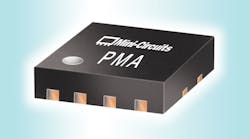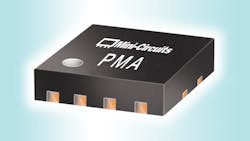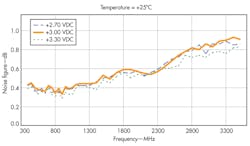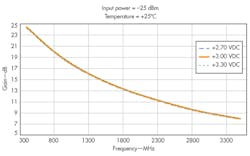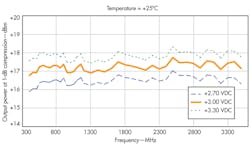This file type includes high resolution graphics and schematics.
Noise can block signals in a receiver and limit the lower end of the system’s dynamic range. For that reason, system designers usually specify a front-end low-noise amplifier (LNA) for the receiver with reasonable small signal gain, so as to boost signals from an antenna with extremely low noise figure. Any noise added to the system at that point stays with the system and tends to become indistinguishable from the desired signals, making communications less effective.
Related Articles • Current-Mode Amp Powers 2.4 GHz • Doherty Amp Boosts China’s LTE Signals • GaN Amps Power CATV ApplicationsTraditionally, LNAs with noise figures approaching 1 dB at RF/microwave frequencies were considered good insurance against noise contamination early in a receiving system. But the model PMA2-33LN+ LNA from Mini-Circuits sets a new mark for noise figure, with typical performance of 0.37 dB noise figure at 900 MHz. The packaged amplifier, which is usable from 400 MHz to 3 GHz, further impresses at the other end of the dynamic range with a third-order intercept point (IP3) of typically +34 dBm at 900 MHz and +40 dBm at 3 GHz.
The model PMA2-33LN+ LNA (Fig. 1) is supplied in a compact, 8-lead, 2 x 2 x 0.55 mm MCLP housing with low inductance and repeatable transitions, providing low-loss thermal connections to a printed-circuit board (PCB). To further support the low noise figure and smooth thermal transitions, the LNA housing incorporates a SnAgNi lead finish.
1. Model PMA2-33LN+ is a packaged GaAs E-pHEMT low-noise amplifier that also boasts high gain and reasonably high output power.
The amplifier is based on the 0.25-μm GaAs enhancement-mode pseudomorphic high-electron-mobility-transistor (E-pHEMT) technology usually associated with high-power or large-signal transistors and amplifiers, but adapted here to low-noise applications. The LNA is designed to operate on a single +3-VDC voltage supply. It provides high reliability with a low operating current of nominally 58 mA across an operating temperature range of -40 to +85°C. On-die electrostatic-discharge (ESD) protection is included in accordance with Class 1A (ESD) requirements [per the 250-V Human Body Model (HBM)].
2. The model PMA2-33LN+ maintains noise figure well below 1 dB across its operating voltages and frequency ranges.
The dynamic range of a communications system can be increased by boosting transmit power or improving the noise figure and sensitivity of the receiver, and it is usually easier to modify the receiver than to boost the power levels of the transmitter. The new LNA should help improve a wide range of receivers. Its noise figure is impressive throughout its operating frequency range (Fig. 2), with typical noise figures of 0.64 dB at 400 MHz, 0.37 dB at 900 MHz, 0.48 dB at 1.5 GHz, 0.58 dB at 2.0 GHz, and 0.86 dB at 3.0 GHz. The amplifier’s small-signal gain (Fig. 3) is 24.0 dB at 400 MHz, 18.7 dB at 900 MHz, 14.5 dB at 1.5 GHz, 12.1 dB at 2.0 GHz, and 8.5 dB at 3.0 GHz.
3. The compact LNA also provides high gain across its wide operating-frequency range.
This file type includes high resolution graphics and schematics.
How It Compares
This file type includes high resolution graphics and schematics.
The E-pHEMT amplifier represents something of a new breed of amplifier in that it exhibits an extremely low noise figure, yet also delivers high output levels. In general, the choice from an amplifier is one or the other, low noise or high output power—and adding too much gain can lead to conditions of instability (or oscillation) that cannot be overcome even through careful impedance matching. The combination of low noise and high output power would indicate that the model PMA2-33LN+ LNA is well suited for processing digitally modulated or even pulsed signals without degradation of signal linearity. Coupled with its noise figure, it also offers relatively high output power at 1-dB compression (Fig. 4), of typically +17.3 dBm at 400 MHz, +17.8 dBm at 900 MHz, +17.7 dBm at 1.5 GHz, +18.1 dBm at 2.0 GHz, and +17.5 dBm at 3.0 GHz. Similarly, the output IP3 is typically +30.0 dBm at 400 MHz, +34.2 dBm at 900 MHz, +36.1 dBm at 1.5 GHz, +37.4 dBm at 2.0 GHz, and +40.0 dBm at 3.0 GHz.
4. Model PMA2-33LN+ LNA delivers respectable output performance, making it suitable for complex digital modulation formats.
The MMIC LNA has measured input return loss of typically 10.0 dB at 400 MHz, 12.4 dB at 900 MHz, 12.5 dB at 1.5 GHz, 13.3 dB at 2.0 GHz, and 20.0 dB at 3.0 GHz. The measured output return loss is typically 18.0 dB at 400 MHz, 25.6 dB at 900 MHz, 22.7 dB at 1.5 GHz, 22.4 dB at 2.0 GHz, and 20.0 dB at 3.0 GHz.
The new LNA is well suited for receiver applications in base-station infrastructure, portable wireless equipment, Long Term Evolution (LTE), Global Positioning Systems (GPSs), GSM telephones, and airborne radar systems. It achieves considerably lower noise figure than other amplifiers in its frequency range, notably those in a low-cost surface-mount housing. Still, there is no discounting the importance of achieving a good input and output impedance match between a system’s other components, such as the antenna and frequency mixer, and the LNA. Proper impedance matches can ensure reaching the noise figures at each frequency cited by the product data sheet.
Where does all the noise come from? As found in active devices such as transistors and amplifiers, noise stems from a number of different sources. One of these noise components, thermal noise, occurs because of vibrations between conduction electrons and holes at a finite temperature. Some of these vibrations have spectral content and may contribute noise over a specific band of interest, although the noise spectrum produced by thermal noise is nearly uniform across RF and microwave frequencies. The power from a thermal source delivering into an impedance matched load is the well-known relationship kTB (in W), where k = Boltzmann’s constant (1.38 x 10-23 J/K); T = the temperature (in K); and B is = system’s noise bandwidth. The power is independent of the source impedance and is directly proportional to the bandwidth, so that a situation with twice the bandwidth would allow twice the noise power to be delivered to the load.
Another noise component is shot noise, which arises from the quantized nature of current flow. Various other noise components follow this quantized behavior. The noise floor for an amplifier is also related to the bandwidth, and can be found from the relationship:
Noise floor = -174 dBm + noise figure +10log(bandwidth)
where the noise figure and bandwidth refer to the LNA under investigation.
Related Articles • Current-Mode Amp Powers 2.4 GHz • Doherty Amp Boosts China’s LTE Signals • GaN Amps Power CATV ApplicationsIn any communications system, the signal-to-noise ratio (SNR) is an important parameter in establishing coherent communications, and it is generally at the antenna and the receiver LNA where the lower end of the SNR is established. In an analog system, deterioration of the receiver front-end noise figure will result in a loss of signal sensitivity. In a digital system, the result will be a degradation in system bit-error-rate (BER) performance. In any case, the front-end LNA is a key component in many receivers and the availability of an amplifier with a lower noise figure helps to improve sensitivity and the overall SNR for systems in which the frequency bandwidth is a fit.
In fact, a digital system’s BER performance can be much more reliant on receiver SNR performance than a comparable analog radio. When systems operate with digital modulation, the situation is similar, and unwanted noise can be highly disruptive to system performance. The model PMA2-33LN+ LNA brings a new dimension to some of these systems because it combines such a low noise figure with moderately good output characteristics, such as output power at 1-dB compression and third-order-intercept (IP3) point. This combination makes it a nice fit for modern digital communications systems where complex digitally modulated signals must be received and preserved.
Mini-Circuits, P.O. Box 350166, Brooklyn, NY 11235-0003; (718) 934-4500, FAX: (718) 332-4661, www.minicircuits.com.
This file type includes high resolution graphics and schematics.
